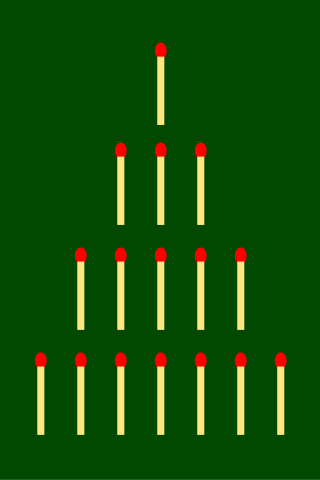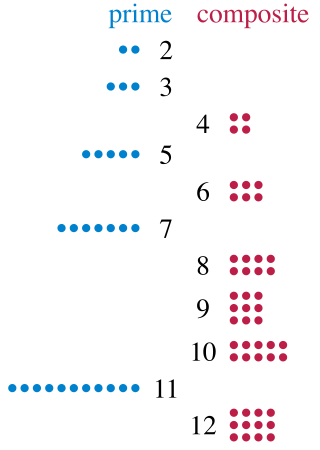Related Research Articles

Nim is a mathematical game of strategy in which two players take turns removing objects from distinct heaps or piles. On each turn, a player must remove at least one object, and may remove any number of objects provided they all come from the same heap or pile. Depending on the version being played, the goal of the game is either to avoid taking the last object or to take the last object.

A prime number is a natural number greater than 1 that is not a product of two smaller natural numbers. A natural number greater than 1 that is not prime is called a composite number. For example, 5 is prime because the only ways of writing it as a product, 1 × 5 or 5 × 1, involve 5 itself. However, 4 is composite because it is a product (2 × 2) in which both numbers are smaller than 4. Primes are central in number theory because of the fundamental theorem of arithmetic: every natural number greater than 1 is either a prime itself or can be factorized as a product of primes that is unique up to their order.

In mathematics, parity is the property of an integer of whether it is even or odd. An integer is even if it is divisible by 2, and odd if it is not. For example, −4, 0, and 82 are even numbers, while −3, 5, 7, and 21 are odd numbers.
In mathematics, for given real numbers a and b, the logarithm logb a is a number x such that bx = a. Analogously, in any group G, powers bk can be defined for all integers k, and the discrete logarithm logb a is an integer k such that bk = a. In number theory, the more commonly used term is index: we can write x = indra (mod m) (read "the index of a to the base r modulo m") for r x ≡ a (mod m) if r is a primitive root of m and gcd(a,m) = 1.

Combinatorial game theory is a branch of mathematics and theoretical computer science that typically studies sequential games with perfect information. Study has been largely confined to two-player games that have a position that the players take turns changing in defined ways or moves to achieve a defined winning condition. Combinatorial game theory has not traditionally studied games of chance or those that use imperfect or incomplete information, favoring games that offer perfect information in which the state of the game and the set of available moves is always known by both players. However, as mathematical techniques advance, the types of game that can be mathematically analyzed expands, thus the boundaries of the field are ever changing. Scholars will generally define what they mean by a "game" at the beginning of a paper, and these definitions often vary as they are specific to the game being analyzed and are not meant to represent the entire scope of the field.
In mathematics, Dickson's lemma states that every set of -tuples of natural numbers has finitely many minimal elements. This simple fact from combinatorics has become attributed to the American algebraist L. E. Dickson, who used it to prove a result in number theory about perfect numbers. However, the lemma was certainly known earlier, for example to Paul Gordan in his research on invariant theory.
In combinatorial game theory, the strategy-stealing argument is a general argument that shows, for many two-player games, that the second player cannot have a guaranteed winning strategy. The strategy-stealing argument applies to any symmetric game in which an extra move can never be a disadvantage. A key property of a strategy-stealing argument is that it proves that the first player can win the game without actually constructing such a strategy. So, although it might prove the existence of a winning strategy, the proof gives no information about what that strategy is.

Richard Kenneth Guy was a British mathematician. He was a professor in the Department of Mathematics at the University of Calgary. He is known for his work in number theory, geometry, recreational mathematics, combinatorics, and graph theory. He is best known for co-authorship of Winning Ways for your Mathematical Plays and authorship of Unsolved Problems in Number Theory. He published more than 300 scholarly articles. Guy proposed the partially tongue-in-cheek "strong law of small numbers", which says there are not enough small integers available for the many tasks assigned to them – thus explaining many coincidences and patterns found among numerous cultures. For this paper he received the MAA Lester R. Ford Award.

The angel problem is a question in combinatorial game theory proposed by John Horton Conway. The game is commonly referred to as the angels and devils game. The game is played by two players called the angel and the devil. It is played on an infinite chessboard. The angel has a power k, specified before the game starts. The board starts empty with the angel in one square. On each turn, the angel jumps to a different empty square which could be reached by at most k moves of a chess king, i.e. the distance from the starting square is at most k in the infinity norm. The devil, on its turn, may add a block on any single square not containing the angel. The angel may leap over blocked squares, but cannot land on them. The devil wins if the angel is unable to move. The angel wins by surviving indefinitely.

Chomp is a two-player strategy game played on a rectangular grid made up of smaller square cells, which can be thought of as the blocks of a chocolate bar. The players take it in turns to choose one block and "eat it", together with those that are below it and to its right. The top left block is "poisoned" and the player who eats this loses.
In mathematics, Euclid numbers are integers of the form En = pn # + 1, where pn # is the nth primorial, i.e. the product of the first n prime numbers. They are named after the ancient Greek mathematician Euclid, in connection with Euclid's theorem that there are infinitely many prime numbers.
Determinacy is a subfield of set theory, a branch of mathematics, that examines the conditions under which one or the other player of a game has a winning strategy, and the consequences of the existence of such strategies. Alternatively and similarly, "determinacy" is the property of a game whereby such a strategy exists. Determinacy was introduced by Gale and Stewart in 1950, under the name "determinateness".

Grundy's game is a two-player mathematical game of strategy. The starting configuration is a single heap of objects, and the two players take turn splitting a single heap into two heaps of different sizes. The game ends when only heaps of size two and smaller remain, none of which can be split unequally. The game is usually played as a normal play game, which means that the last person who can make an allowed move wins.
In mathematics, a Størmer number or arc-cotangent irreducible number is a positive integer for which the greatest prime factor of is greater than or equal to . They are named after Carl Størmer.
The vast majority of positive results about computational problems are constructive proofs, i.e., a computational problem is proved to be solvable by showing an algorithm that solves it; a computational problem is shown to be in P (complexity) by showing an algorithm that solves it in time that is polynomial in the size of the input; etc.

In graph theory, Conway's 99-graph problem is an unsolved problem asking whether there exists an undirected graph with 99 vertices, in which each two adjacent vertices have exactly one common neighbor, and in which each two non-adjacent vertices have exactly two common neighbors. Equivalently, every edge should be part of a unique triangle and every non-adjacent pair should be one of the two diagonals of a unique 4-cycle. John Horton Conway offered a $1000 prize for its solution.

In geometry, a Danzer set is a set of points that touches every convex body of unit volume. Ludwig Danzer asked whether it is possible for such a set to have bounded density. Several variations of this problem remain unsolved.
In combinatorial game theory, a subtraction game is an abstract strategy game whose state can be represented by a natural number or vector of numbers and in which the allowed moves reduce these numbers. Often, the moves of the game allow any number to be reduced by subtracting a value from a specified subtraction set, and different subtraction games vary in their subtraction sets. These games also vary in whether the last player to move wins or loses. Another winning convention that has also been used is that a player who moves to a position with all numbers zero wins, but that any other position with no moves possible is a draw.
References
- ↑ Guy, Richard K. (1976). "Twenty questions concerning Conway's Sylver Coinage". Research Problems. American Mathematical Monthly . 83 (8): 634–637. doi:10.2307/2319892. JSTOR 2319892. MR 1538138.
- 1 2 3 4 5 6 Berlekamp, Elwyn R.; Conway, John H.; Guy, Richard K. (1982). "18. The Emperor and His Money" (PDF). Winning Ways for your Mathematical Plays, Vol. II: Games in Particular. Academic Press. pp. 575–606.
- 1 2 Sicherman, George (2002). "Theory and Practice of Sylver Coinage" (PDF). Integers. 2. G2.
- ↑ Sylvester, James J. (1884). "Question 7382". Mathematical Questions. Educational Times. 41: 21.
- 1 2 3 Guy, Richard K. (2004). "C7. The money-changing problem". Unsolved problems in number theory (3rd ed.). Springer-Verlag. pp. 171–174. ISBN 978-0-387-20860-2. Zbl 1058.11001.
- ↑ Conway, John H. (2017). "Five $1,000 Problems (Update 2017)" (PDF). On-Line Encyclopedia of Integer Sequences . Retrieved 2019-02-12.